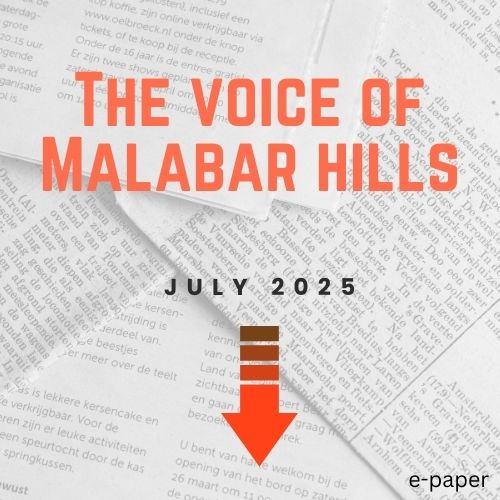The Mahalaxmi Temple Complex from Cumballa Hill, 1865
When first encountering this view, the thought that instantly comes to (at least my) mind is – could the busy Pedder Road / Haji Ali junction ever have been this serene? Captioned as “Mahaluxmee” by the artist, and combined with the fact that the summit of the Dhakleshwar Temple (of the Mahalaxmi Temple Complex) can be seen in the middle distance, we have a precise location to pinpoint for this view. But it was nevertheless labelled “Village in Bombay” by a previous owner, who probably anyways didn’t know any better, and went by what they saw, as that is precisely what it looks like at first glance.

n the year 1865 (dated bottom left), the Mahalaxmi area was indeed a village on the cusp of change, being called so after it’s temple namesake. It was also a year of considerable tumult in town, with the speculation into cotton prices and land reclamation projects of the previous few years crashing spectacularly as the American Civil War ends and British embargo on American cotton gets lifted, deeming Bombay less essential to the supply side of things, and rendering many of it’s richest inhabitants bankrupt virtually overnight.
Even with the thick foliage & towering palms populating this view, by this time, several townhouses, many belonging to Company officers & wealthy Indian merchants, had begun to sprout about, being of sufficient distance from the Fort area to allow for countryside excursions, which even included hunting wild animals for sport. The actual fort had been demolished over the last few years, with the town limits quickly expanding following this seminal decision, & combined with the advent of cotton mills & railways, Bombay would fairly quickly be relieved of it’s rural character.
All of the area seen here in the foreground was sketched from a point presumably somewhere above where the Heera Panna building stands today, with much of the land belonging to the Gamadia family for some decades of the 19th and 20th centuries. Pedder Road didn’t exist yet, and wouldn’t come up for a number of years. This watercolour was sketched by one John Frederick Lester (1825-1915). Little is known about him, except that his forwarding address in Bombay was the premises of Remington & Co., a leading firm with varied interests in Fort, that he was in Bombay until at least 1875, and a beautiful album of his watercolour works, many of them related to Bombay, reside in the collection of the British Library in London.
The Mahalaxmi Temple Complex history is quite entangled in the myth surrounding it – even though built into it’s present form in the 1830s, about half a century after the English East India Company were supposedly finally successful in breaching off an intertidal zone (the dam or ‘vellard’ exists today as Lala Lajpat Rai Marg, colloquially known as the Haji Ali Road) due to the emergence of the original idols (the other two being of Mahakali and Mahasaraswati) hidden away during the Portuguese era, in reality there are records of the first successful taming of the breach in the 1710s by one Captain Bates and under the governorship of Charles Boone. The story in popular folklore is just that – a better story to advertise the prowess of the emerging Company on the verge of becoming enormously successful. Further, since the early attempt at the dam was only partially successful (made of mud and stone, mostly from quarrying hills in and around the island, flooding into Central Mumbai did still occur at times), it was also one of many early attempts of a fledgling Company to hide away their past failures and shortcomings.
One final parting thought – there exists a non-descript journal in the collection of the National Maritime Museum, Greenwich, which has a rough sketch of Bombay by a British navigator from the year 1626, the absolute earliest-ever British view of Bombay. After some analysis in the late 19th century, it was determined to have been sketched from somewhere off the coast of Worli, possibly from somewhere in the water that we see here. And I wonder whether, being still the Portuguese period, if the original Mahalaxmi temple was sighted at the time, in all it’s past glory (simplicity?), before the idol was to be hidden away, only to take the island to obscene wealth once finally reinstated.
(Picture and article by Mrinal Kapadia, resident of Cumballa Hill, he is a collector and researcher, and can be reached on mrinal.kapadia@gmail.com or via Instagram on @mrinal.kapadia)





